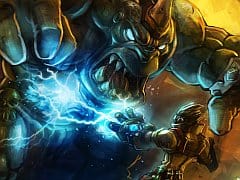Video Gamer is reader-supported. When you buy through links on our site, we may earn an affiliate commission. Prices subject to change. Learn more
Torchlight, originally released for PC in 2009, was a successful addition to a genre of Diablolikes. For anyone who spent the noughties waiting for Diablo 3 to turn up on shelves – for anyone who’s still waiting for a bloody release date – Runic Games’ title was a stopgap, one of a few in the last decade. Now little Torchlight is all grown up and making the move from PC exclusive to XBLA game. And impressively it’s done this without losing anything in translation – a surprise for the fans who thought it could never exist without a mouse.
As in PC version you choose from one of three characters. There’s the melee Destroyer, a Lou Ferrigno-sized warrior; a ranged Vanquisher whose strategy largely involves laying down traps – a slightly more tactical approach to combat than your melee pal; and a magic focused Alchemist who can summon imps and golems.
Although you have these three very specific character types there’s some overlap between them. The Destroyer, for instance, has the option to unlock magical abilities. Even beyond class-specific abilities, any of the characters can use scrolls to learn spells regardless of their individual talents.
The town of Torchlight itself is essentially a standard RPG village-cum-mining town built directly above a monster infested mine. The villagers dig for Ember, a type of ore that can be used to enchant objects and also lusted after by the magically-inclined, but naturally the Ember has a dark side. The storyline is utterly secondary to the gameplay, but what follows is a series of quests that have you travelling continuously deeper into the mine to find the source of the monsters clogging up the place. The mine is comprised of 35 floors of randomised dungeons à la the original Diablo, offering a veritable buffet of the old classical locations – you have your necropolis, you have jungle ruins, and there’s your classic grey-brick castle. While the game relies on the tropes of a bygone era it perfects what dungeon crawlers specialise in: OCD gameplay, constant rewards, and floors blanketed with loot.
But Torchlight isn’t impersonating its peers as much as collecting a few of the genre’s best features in one place; features the team previously had a hand in. Travis Baldtree, the high muckity-muck of the studio had previously worked on the MMO Mythos and before that on Fate – a game that Torchlight borrows heavily from – and the use of pets, for example, is there largely thanks to Baldtree’s Fate.
In Torchlight your hero is accompanied by a tag-along animal (your choice of wolf, bobcat or dragon) that you can name, equip with spells, and use as a fighting companion. That hints at the kind of variety you have in the combat. Pets alone offer a surprising level of complexity on top of what’s essentially a traditional dungeon crawler, functioning as a basic substitute for co-op. Set your animal to aggressive and it functions as a makeshift tank for Vanquisher or Alchemist builds, or set it to passive and hand it a healing spell if you’ve gone Destroyer. Other times you’ll use your pet as a backpack to hold items, or send them back to town to sell unwanted goods coughed out of enemy corpses.
You can thank Fate again for the fishing system used in Torchlight. Dungeons have a few stray fishing holes littered about that can be used to catch… well, take a guess. Feeding your pet a fish transforms them into various kinds of monsters with stronger attacks, giving a bit more variation to your pet’s combat skills.
Unfortunately on a console, fights control a bit less accurately than you might remember from the game’s PC days. You can auto-target the nearest enemy with the left analogue stick, but once you’re surrounded by a mob targeting specific monsters becomes as difficult as trying to punch a single bee out of a hive. This too causes a few problems: now and then the scene erupts in a very noticeable drop in frame rate when too many mobs fill the screen, although in reality it’s only a minor issue considering it’s fairly rare.
Regardless of the occasionally awkward targeting in Torchlight, this isn’t a game for pin-pointing certain enemies or picking off stragglers; this is a game that encourages you to pull off an array of abilities until your enemies collectively turn into a combination of splatter and loot. As you level up you can mix-and-match abilities and spells from an impressively varied skill tree. You’ll have four of them readily available at any given point and can swap them for another set of four with the d-pad: easily and quickly accessible abilities that encourage the kind of blindly frenetic pace that Torchlight perfected on PC.
In fact in some ways the pace of the game feels like it’s more naturally suited for a controller, despite the few glitches that end up rearing their head. Movement feels smoother with the analogue stick, and that inevitably helps when you’re crawling your way through hordes of skeletons. While PC players might miss the standard hot keys they were used to, Torchlight on XBLA is proof that they’re by no means necessary. Ten years on from Diablo and it still has enough influence over modern games to power a generation of clones, but both Torchlight and its developer prove to be one the perfect students of the genre.

/https://oimg.videogamer.com/images/f896/torchlight_4.jpg)